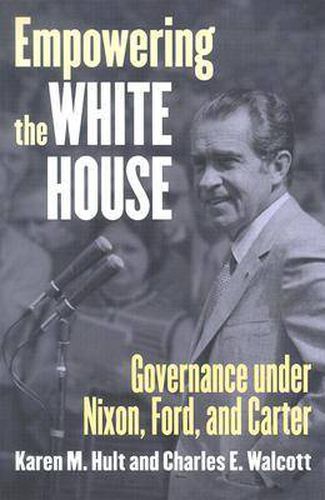Readings Newsletter
Become a Readings Member to make your shopping experience even easier.
Sign in or sign up for free!
You’re not far away from qualifying for FREE standard shipping within Australia
You’ve qualified for FREE standard shipping within Australia
The cart is loading…






On the surface the new president seems to inherit an empty house, Hugo Heclo, a recognized expert on American democratic institutions, has noted.
In fact, he enters an office already shaped and crowded by other people’s desires .
Empowering the White House
examines how Richard Nixon entered that crowded Oval Office in 1969 yet managed to change it in a way that augmented the power of presidency and continues to influence into the 21st century how his successors have governed. Nixon’s White House is perhaps best remembered for the growth in the size of the staff, which operated under the supposed iron fist of H.R. Haldeman. But more important than size and management style to the character of the Nixon White House were the assigned tasks, complexity and dynamics of the burgeoning staff. Faced with hostile majorities in congress and executive branch careerists assumed to be committed to a Democratic agenda, Nixon sought to control his political fate by engaging more actively than earlier presidents in public relations and the mobilization of support. At the command and under the control of the Oval Office, the staff carried out assignments designed to fulfill Nixon’s aims. This theoretically informed and well-researched study explains how Nixon changed and expanded the institutionalized presidency and how that affected the Ford and Carter administrations. Nixon ushered in a new stage in the modern presidency by organizing and using his increasingly complex staff in new ways that have persisted beyond the 1970s to this day. To a greater degree than any predecessor, Nixon systematized outreach, legal advice and policy formulation. His White House staffing, then, has come to be regarded as a
standard model
that influences incoming presidents regardless of party affiliation. Leavening this organizational study are revealing accounts of how Nixon, Ford and Carter staff operated behind the scenes in the West Wing. Anyone needing to know how the White House worked during those presidencies - or how it has worked since - should find this book useful.
$9.00 standard shipping within Australia
FREE standard shipping within Australia for orders over $100.00
Express & International shipping calculated at checkout
On the surface the new president seems to inherit an empty house, Hugo Heclo, a recognized expert on American democratic institutions, has noted.
In fact, he enters an office already shaped and crowded by other people’s desires .
Empowering the White House
examines how Richard Nixon entered that crowded Oval Office in 1969 yet managed to change it in a way that augmented the power of presidency and continues to influence into the 21st century how his successors have governed. Nixon’s White House is perhaps best remembered for the growth in the size of the staff, which operated under the supposed iron fist of H.R. Haldeman. But more important than size and management style to the character of the Nixon White House were the assigned tasks, complexity and dynamics of the burgeoning staff. Faced with hostile majorities in congress and executive branch careerists assumed to be committed to a Democratic agenda, Nixon sought to control his political fate by engaging more actively than earlier presidents in public relations and the mobilization of support. At the command and under the control of the Oval Office, the staff carried out assignments designed to fulfill Nixon’s aims. This theoretically informed and well-researched study explains how Nixon changed and expanded the institutionalized presidency and how that affected the Ford and Carter administrations. Nixon ushered in a new stage in the modern presidency by organizing and using his increasingly complex staff in new ways that have persisted beyond the 1970s to this day. To a greater degree than any predecessor, Nixon systematized outreach, legal advice and policy formulation. His White House staffing, then, has come to be regarded as a
standard model
that influences incoming presidents regardless of party affiliation. Leavening this organizational study are revealing accounts of how Nixon, Ford and Carter staff operated behind the scenes in the West Wing. Anyone needing to know how the White House worked during those presidencies - or how it has worked since - should find this book useful.